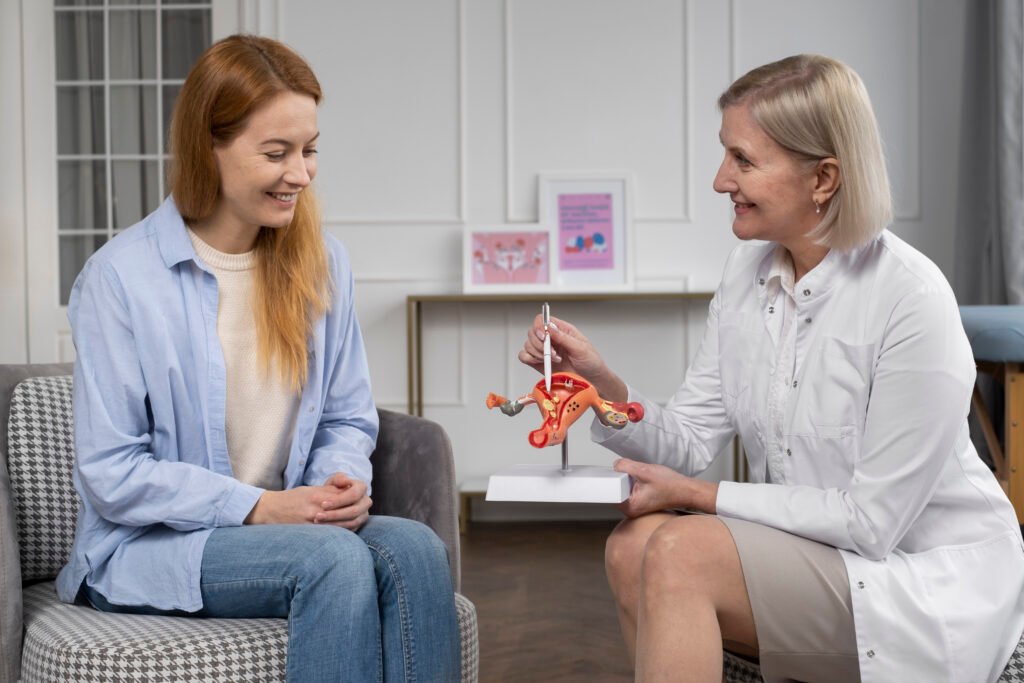Gynecology
Specializing in Minimally Invasive Surgery
Robotic Surgery: Utilizing state-of-the-art robotic technology to enhance precision and minimize recovery time, allowing for quicker healing and less postoperative discomfort.
Minimally Invasive Techniques: Procedures such as laparoscopy and hysteroscopy that reduce scarring and promote faster recovery, all while maintaining high standards of care.

Our Gynecological Services
Routine Gynecological Exams
Annual pelvic exams and Pap smears for early detection of cervical cancer. Comprehensive breast examinations and education on breast health.
Family Planning and Contraceptive Counseling
Personalized guidance on contraceptive options, including hormonal methods, IUDs, and natural family planning. Preconception counseling for women planning to conceive
Management of Menstrual Disorders
Evaluation and treatment of irregular periods, heavy bleeding, and painful menstruation (dysmenorrhea). Strategies for managing premenstrual syndrome (PMS) and premenstrual dysphoric disorder (PMDD)
Menopause Care
Support and management of menopausal symptoms, including hot flashes, mood changes, and vaginal dryness. Hormone replacement therapy (HRT) options and alternatives.
Evaluation and Treatment of Pelvic Pain
Comprehensive assessment and management of chronic pelvic pain, including conditions such as endometriosis and pelvic inflammatory disease (PID). Minimally invasive diagnostic procedures and treatments.
Gynecologic Surgery
Advanced minimally invasive surgical options, including laparoscopic and robotic-assisted procedures for conditions such as fibroids, ovarian cysts, and endometriosis. Hysterectomy and other surgical interventions tailored to your needs
Sexual Health and Wellness
Counseling and treatment for sexual dysfunction, intimacy issues, and sexually transmitted infections (STIs). Education on sexual health and preventive measures.
Screening and Prevention
Comprehensive STI screenings and preventive care. Tailored health education and resources to promote overall wellness
Abnormal Pap Smears
Many women with an abnormal Pap smear mistakenly believe that they have cancer If you are young, you are in danger of being over treated If you have avoided Pap smears for a long time you are in danger of being undertreated My goal is to see that you are treated appropriately
Endometriosis
Endometriosis tends to slowly worsen and cannot be reliably diagnosed by Physical Examination alone. This condition does not reliably show up on ultrasound, CAT scan or MRI. Surgical diagnosis.Normally we diagnose endometriosis in the course of trying to manage pelvic pain.
Fibroids
Sometimes Fibroid removal is desirable to enhance fertility, reduce pain or bleeding but most of the time if a woman is having no symptoms, I reassure her that no treatment is necessary
Hormone Therapies
Hormone Therapies refers to the use of estrogen and progesterone or estrogen alone. Estrogen is the hormone that relieves the symptoms. Women with a uterus must also take progesterone to prevent uterine cancer. Women who have had a hysterectomy – may be treated with estrogen alone.
Ovarian Cysts
Each month a woman forms a cyst in preparation to ovulate (releasing an egg) after egg release, another cyst forms called a corpus luteum. Either cyst may become larger or more painful than usual.
Vaginal Infections
The most common vaginitis. Caused by a shift in the balance of vaginal bacteria with less of the normal healthy bacteria and more of the type that may produce odor and discharge. Maybe recurrent and difficult to cure
Gynecology FAQs
SMOKING CESSATION COUNSELING: Stopping smoking is one of the very best things you can do for yourself. The relationship between cigarette smoking, heart and blood vessel disease, lung cancer and shortened Lifespan has been clearly proven. Quitting is NOT easy but being prepared may help. To help you quit, you need the proper tools.
WHY QUIT?: Approximately 22% of US women smoke, and nearly 174,000 die annually from smoking-related conditions. The top 4 causes of death in women are heart disease, cancer, stroke, and chronic lower respiratory diseases, accounting for mortality rates of 27.3%, 22%, 7.5%, and 5.2%, The risk for death from each is dramatically increased by smoking. In the Nurses’ Health Study, 64% of the deaths in current smokers were attributable to smoking.
EARLIER MENOPAUSE: Women who smoke cigarettes go through menopause earlier than nonsmokers.
WEAK BONES: Women who smoke cigarettes are at increased risk for weak bones, prone to fracture (osteoporosis).
PREGNANCY DAMAGE: Pregnant women who smoke are at increased risk for dangerous complications, including placental abruption, preterm labor, low infant birth weight, and infertility.
ABNORMAL PAP SMEARS: Also, the risks for cervical pre-cancer and cancer are markedly increased in women who smoke, and smokers are more likely to have persistent abnormal pap smears.
TREATMENTS:
…NICOTINE REPLACEMENT THERAPY:(Gum, Patch, Lozenge 19-23% success).
…ANTI-DEPRESSANTS:(Wellbutrin pill 2x/day, Insomnia, dry mouth-24% success, not for patients with seizures or eating disorders).
…CHANTIX: Has the highest success rate at 33%. Side effects include Nausea, trouble sleeping and abnormal dreams.
NOTE: BOTH CHANTIX AND WELLBUTRIN MAY BE ASSOCIATED WITH NEUROPSYCHIATRIC SYMPTOMS, STOP IF MAJOR MOOD PROBLEMS EXPERIENCED.
I RECOMMEND:
1. Pick a quit date.
2. Fill prescription for medication
3. Start a behavioral support program.
BEST WEBSITES:(My opinion).
Load a Phone App on your Android or iPhone to help you!.
Consider: Quit Smoking: Cessation Nation by Ron Horner.
MyTmeToQuit.com – for Chantix users – includes free telephone support from Mayo Clinic trained Telephone counseling
Quitnet.org – the Web’s original quit smoking site.
Smokefree.gov/
Surgeongeneral.gov/tobacco/
CDC.gov/tobacco/quit_smoking/index.htm
Smokefreefamilies.org – for help stopping during pregnancy.
SLEEP COUNSELING:
HOW MUCH SLEEP:( DO YOU NEED?) Adults need an average of 8-8 1/2 hours of sleep a night, although it ranges from 6 1/2 to 9 hours. Mortality studies suggest you live longer if you get 7 hours or more of sleep each night.
DRUGS THAT CAUSE INSOMNIA: Include Caffeine, alcohol, other central nervous system stimulants, some antidepressants, Decongestants, some antihistamines, some other cold, allergy, and asthma drugs, drugs taken for digestive disorders, Beta Blockers, Thyroid hormone replacement medications. STOP them or try to reduce dose.
TIPS FOR BETTER SLEEPING:
Find out whether a medical condition or any medications you’re taking could affect sleep.
THINGS TO AVOID: Caffeine, nicotine, alcohol – for at least four hours before you go to bed.
HELPFUL BEHAVIORS:
Be predictable. Go to bed around the same time every night.
Don’t toss and turn. If you can’t sleep after 20 minutes, get out of bed and do something else.
Save the bedroom for sleep and sex. Avoid bedroom bill paying, TV watching or reading the paper.
Take a warm shower or bath this may nudge your bedtime biochemistry along.
Face your alarm clock away from the bed.Exercise early.
If you exercise, do it before dinner, not after.
Get dark. People usually sleep best in a quiet, cool, dark environment.
Invest in heavy drapes if city lights glare outside.
PROPER EATING: Grab a snack. It’s hard to sleep hungry, so try a light snack before bedtime.
Large meals may keep you awake.
Some researchers think tryptophan, a chemical found in milk, naturally induces sleep.
LIMIT NAPS: Cut naps short. If you have trouble falling asleep, avoid naps or limit them to less than an hour before mid-afternoon.
MANAGE STRESS: Deal with stress. If daytime troubles keep you awake, try jotting notes about ways to deal with them. Leave stress at the bedroom door, if you can.
BEST RESOURCES:
NATIONAL CENTER SLEEP DISORDERS RESEARCH:
www.nhlbi.nih.gov/health/public/sleep/
NURSING ONLINE EDUCATION DATABASE:
http://noedb.org/library/features/50-tips-and-resources-to-help-you-sleep-better
